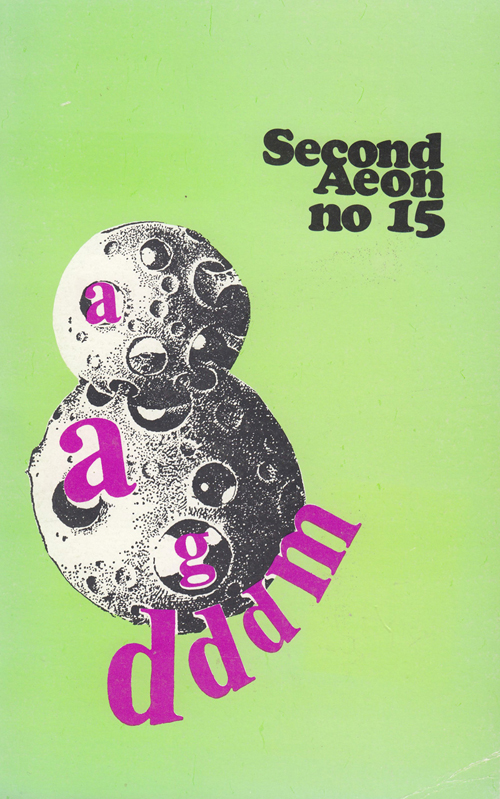The magazine
began at Finch's family home in Queensbury Road, Cardiff
but developed and hugely expanded its reach at his Maplewood
Court flat in Llandaff North. If the spirit of the magazine
still hangs anywhere it is in that ground floor back room.
Finch's Hungarian translator, Kinga Kovacs, visiting from
Budapest, said that one of the aims of her visit was to
get as near to that source as possible. They should put
up a plaque, she said. They won't.
Early issues
featured local poets and others from the small press world.
Issue 4 included Liverpool's Brian Wake, arch-hippie David
Stringer, Peter Hoida, Stephen Morris, Chrissie Smith and
work from the Flemish of Clem Schouwenaars. By issue 6 the
canvas had expended considerably with appearances from,
among others, George Dowden, Jim Burns, Bob Cobbing, Raymond
Garlick, Geraint Jarman, Penguin Modern Poet Alan Jackson,
anti-war sonic chanting from Cavan McCarthy and a Wales
Visitation from Allen Ginsberg.
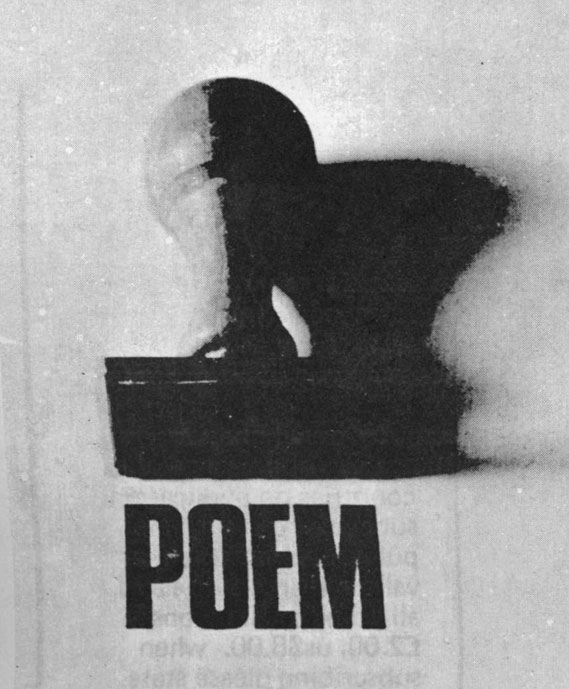
the distance
between maurizio nannucci (above from issue 18)
and r.s.thomas (issue 15) was
regarded by many as uncrossable.
Not that this ever held second aeon back
Mid-period saw
the magazine rise to almost 100 pages an issue. Demand was
increasing as the magazine's fame spread. Issue 8/9 featured
a cover flap containing concrete poems and new work from,
among others, William Wantling, just out of San Quentin
and full of hippie joy, Pablo Neruda, Dom Sylvester Houedard
making haiku out of Llywarch Hen, Doug Blazek in from San
Franscico, Iain Sinclair, a play from Roger McGough, Adrian
Henri, Alan Silitoe, Jim Burns, Geraint Jarman, Tom Kryss,
and an expanding Small Press Scene round up of the poetry
scene. Some of the poets included were of world standing
yet Second Aeon's pages were still banged out on a typewriter
and duplicated on a Gestetner..
Issue 10 ran
a plastic bag full of concrete poem postcards as a freebe.
Harry Guest appeared from Tokyo, Gene Fowler shouted up
from Grand Canyon. Edwin Morgan added his Loch Ness Monster.
Elsewhere were poems from Tina Morris, Barry Macsweeney,
Thomas A Clark, Peter Porter, Mike Horovitz, Iain Sinclair
and Gary Snyder. The Small Press Scene was so large that
it appeared in a pull-out supplement.
At more than
100 pages issue 12 was the final duplicated number. Its
range of featured poets mirrored the best of the poetry
world. Dave Cunliffe, Frances Horovitz, Jeff Nuttall, Tom
Raworth, Dannie Abse, Peter Redgrove, Chris Torrance, John
Tripp, Henri Chopin, Charles Verey. Paul Brown had a short
story woven into an actual map. George Dowden reported from
meditation-filled India. D.r.Wagner wrote in from Sacramento.
Issue 13 saw
a switch to full typesetting and an offset print job. Its
spine was stapled and the Small Press Scene vaster than
ever. The experimental section had grown. Jiri Valoch presented
textfragments, Edwin Morgan showed newspaper poems, Philip
Jenkins restuctured Mark Rothko, dsh, Alison Bielski and
contributed. Elsewhere was an expanded and pretty roaring
poetry world including Opal Nations, Charles Bukowski, Harri
Webb, Adrian Henri, Robert Bly, Emyr Humphreys, George Macbeth,
Penelope Shuttle, Pradip Choudhuri, Bill Wantling telling
us that it wasn't an easy time to be alive and Edwin Morgan,
making his poems from newspapers, assuring us that it was.
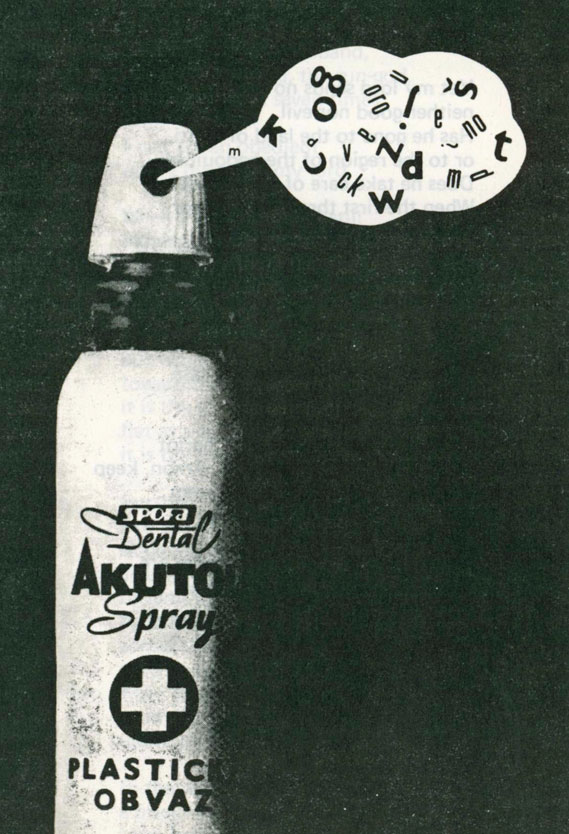
akutol
- poetry - spray by jiri valoch
from second aeon #13
Issues 14 to
the final 21 got progressively fatter, had bright coloured
covers bearing commissioned art work from the likes of Tom
Phillips and Jochen Gerz, and a wild full front-on rush
of contemporary verse. The issues ran controversial critical
pieces, Meredith Monk in Liverpool, John Furnival in America,
Jonathan Griffin's recasting of Mallarme, introductions
to Japanese visual verse, Yugoslav concrete, Clayton Eshleman's
Metro Vavin poetry scam and a substantial analysis from
Eric Mottram of the work of Bob Cobbing. Poets included
Jiri Valoch, Carol Berge, Cid Corman, Charles Plymell, DM
Thomas, Edward Lucie Smith, John Idris Jones, Roy Fuller,
Jack Hirschman and a host of others. If you were out there
writing in these years then your poetry needed to appear
in this magazine. Most poets who could see where the world
was headed sent in their work. The sacks of hopeful contributions
arriving by post at Maplewood Court were huge.
Poets would ring
up at night to recite their verse down the line at the sleep
addled Finch. They would lay in wait outside and pounce
waiving their mss when the editor came home from work. Drinks
were bought when the editor was spotted leaning at the bar
of the local pub, The Pineapple. Bribes were offered and
never taken. Once when a poem was rejected (as most were)
the failed versifier sent a pair of old shoes and a rotting
trout by return.
Editorial policy
was to read the mailbox and to include things if they struck
home but mainly to scour the poetry world at large and ask
the significant for contributions. The jostling avant-gardes
of the flower power era bled into the minimalist and procedural
poetries of the seventies.
For most of its
run Finch edited and produced the magazine single-handedly.
Financial help came from Welsh Arts Council grant aid and
personal sponsorship from the poet and industrialist the
late Cyril Hodges. Cyril would make his donations unannounced
by leaving wodges of cash in envelops on the doormat. Finch
knew what it was for. For a few of its later issues the
poet John Tripp helped compile magazine small press round-ups.
The magazine fattened. Its subscriber list grew ever longer.
The Post Office who disliked having their pillar boxes filled
to overflowing with subscribers' copies offered to stick
the stamps on.
From the magazine
spun Second Aeon Publications. These were a series of small
booklets, broadsheets and later decently sized bound volumes
which eventually reached more than 80 in number. They included
work by John Tripp, Peter Redgrove, William Wantling, Geraint
Jarman, Kent Taylor and a highly successful anthology of
Typewriter Poems edited by Finch. The series sold off the
back of the magazine, often attracting their own discrete
grant aid.
Production for
the magazine itself was initially on a Gestetner duplicator
and as we've seen moving by issue #13 to offset-litho. Print
was by Brown's of Bolton, shipped to Cardiff by articulated
lorry and (once) left outside in stacked brown-paper packets
in the drenching South Wales rain. A boxed full-print run
of a late number Second Aeon took up some space and weighed
a lot more than most imagined. Finch needed a day off following
the galloping rush he found himself engaged in shifting
the crates from drenched drive to dry hallway. The early
booklets were home assembled, collated, long-arm stapled,
trimmed. Later titles were produced professionally by local
jobbing printers. Setting in these pre computer days was
either home done on electric vari-typer with added Letraset
or paid-for via a bureau.
Contributions,
subscriptions, poetry, prose and books and magazines for
review came from all over the world. In storage they filled
at least a double garage, sliding into each other like trawlered
fish. Along with the rest of Second Aeon's papers many now
reside at the Fales Library, New York (see details further
on).
When the magazine
began Finch was working in local government; it ceased when
he moved to a new post running the Welsh Arts Council's
new Charles Street bookshop,Oriel. Giving up the
grant aid was one of the conditions of the post. The magazine
went out while it was still very much on top.
The history of
the period was one of internecine warfare between the traditional
elements in British poetry and those who wished a more catholic,
world-view to take hold. The poets of the British poetry
revival, the creators of innovative verse and the concrete
and visual poets faced down those who held the publishing
levers of power. Things did not stay still for long. Poetry
was moving out of the confining English trenches and into
the larger world. Second Aeon, with its highly catholic
view of literature, was there at just the right time.
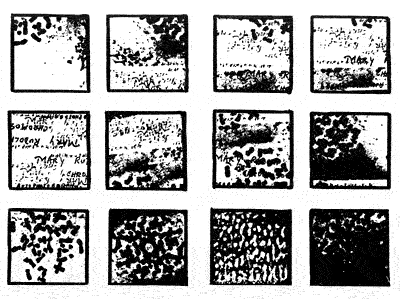
Bob Cobbing
- Mary Rudolf's Chromosomes
from second aeon issue #15
No one in the
UK in the late sixties and the early seventies was much
interested in poetry as a whole art. Nor were there many
formal opportunities to read it outside the Penguin-Faber-OUP-Cape
drawn lines. The small presses, still a vital part of literary
adventure, were then of even greater significance. If you
wanted concrete poetry, chance operations, non-referential,
open field, post-beat, visual, found, collage, or any other
new approach then little magazines were your only hope.
America, despite Carlos Williams and despite Ezra Pound
was still seen as hugely distant. Europe was a continent
you needed a telescope to see. Asia and Africa were lost
in translation.. The Celtic nations were beyond the pale.
To get ahead you needed to be male, centralist and with
the exception of a few adventurous Japanese, very English.
Second Aeon wanted as little part of that as possible.
At one level
the magazine provided a literary link between the poets
of Wales and the rest of the world. Second Aeon
was initially an outlet for local Cardiff writers (through
Finch's involvement with No Walls, the local poetry
workshop) and later for the whole of Wales (through Finch's
work on reading tours, national literary events and the
organisation Poet's Conference of which Finch was
the National representative). On a larger scale Second
Aeon represented the UK to the world and the world to
the UK. Finch was a council member of the London Poetry
Society and of The Association of Little Presses
at this time. He worked to draw the disparate strands of
poetry into a common thread. Second Aeon was supported
by many. It had no central office and no staff. Copies lined
most rooms in Finch's house. This was a literary phenomena.
The UK national press totally ignored it.
"Finch won because his sense of where he was was years
ahead of anyone else; most British editors are in love with
the past" - Andrew Duncan, Nothing Is being Suppressed
- British Poetry of the 1970s, Shearsman, 2022.
"Finch also
edited second aeon which was the only Welsh magazine
of its time to swim with the international avant-garde,
not only for what it printed but for Finch's considered,
small-print reviews of publications both straight and wayward"-
Richard Kostelanetz, Dictionary of the Avant-Gardes,
Chicago Review Press, 1993
How the South
Wales Echo reported Second Aeon in 1968 is here.
How the paper reported the No Walls readings is here.
At London's Poetry
Library you can now read an online version of the great
19-21 final issue of second
aeon with other issues to follow. Babylon
Wales - Notes From The Margins Of Welsh Culture
features the place where it all began - Maplewood
Court
A comprehensive
study by Malcolm Ballin (Cardiff University) Welsh Periodicals
in English: Second Aeon and Poetry Wales (1965-1985)
appears in Welsh Writing In English - A Yearbook
of Critical Essays edited by Tony Brown (CREW - distributed
by University of Wales Press), 2007. This essay which discusses
at length the magazine's relationship with its funders and
its relationship with Wales.
(This essay revised
June, 2022.)
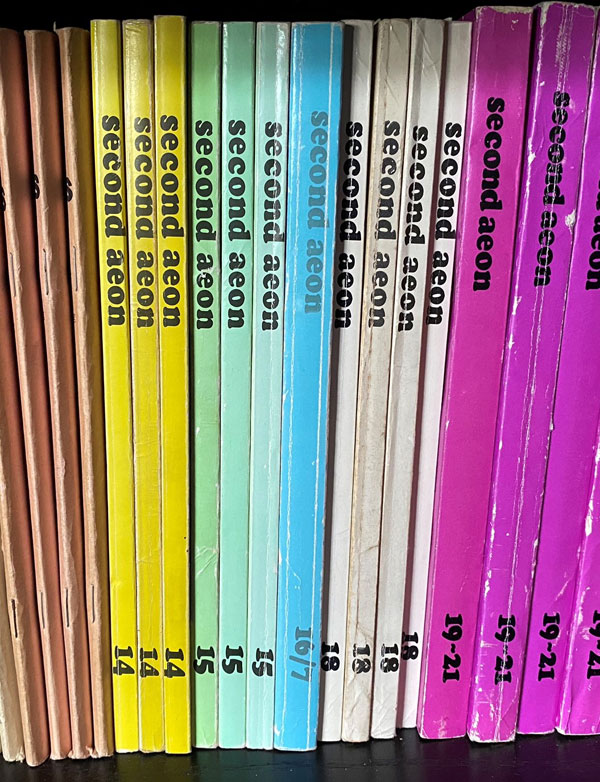
The Second
Aeon Archive 1967 - 1974 is part of The Fales Library
& Special Collections held in New York (Fales Library
and Special Collections Elmer Holmes Bobst Library 70 Washington
Square South New York, NY 10012). The Library notes: "The
Second Aeon Archive is comprised of all the correspondence
and manuscript material that created Second Aeon's issues,
such as: magazine layouts, page proofs, letters to the editor,
illustration layouts, and original manuscripts. Noted correspondents
include Paul Auster, Carol Berg, Robert Bly, Charles Bukowski,
William Burroughs, John Cage, Cyril Hodges, Alison Knowles,
Jim Morrison, Jeff Nuttall, and Peter Redgrove. Also included
in this collection are manuscripts used by Second Aeon's
small press to publish various poetry books and anthologies.
The Second Aeon Archive was acquired via purchase from Richard
Aaron of Am Here Books, in 1974. The Second Aeon Archive
is part of the Avant Garde Collection, collected at Fales
Library during the 1960's and 70's by Mel Edelstein and
Theodore Grieder." Search for: The Fales Library
Special Collections - Guide to the Second Aeon Archive 1967-1974
MSS.023 Dick McBride bought the original papers following
a visit to Maplewood Court in the 1970s. Finch spent the
money realised on his first second-hand car. Later papers
are either at the National Library of Wales or remain in
the editor's personal collection.
